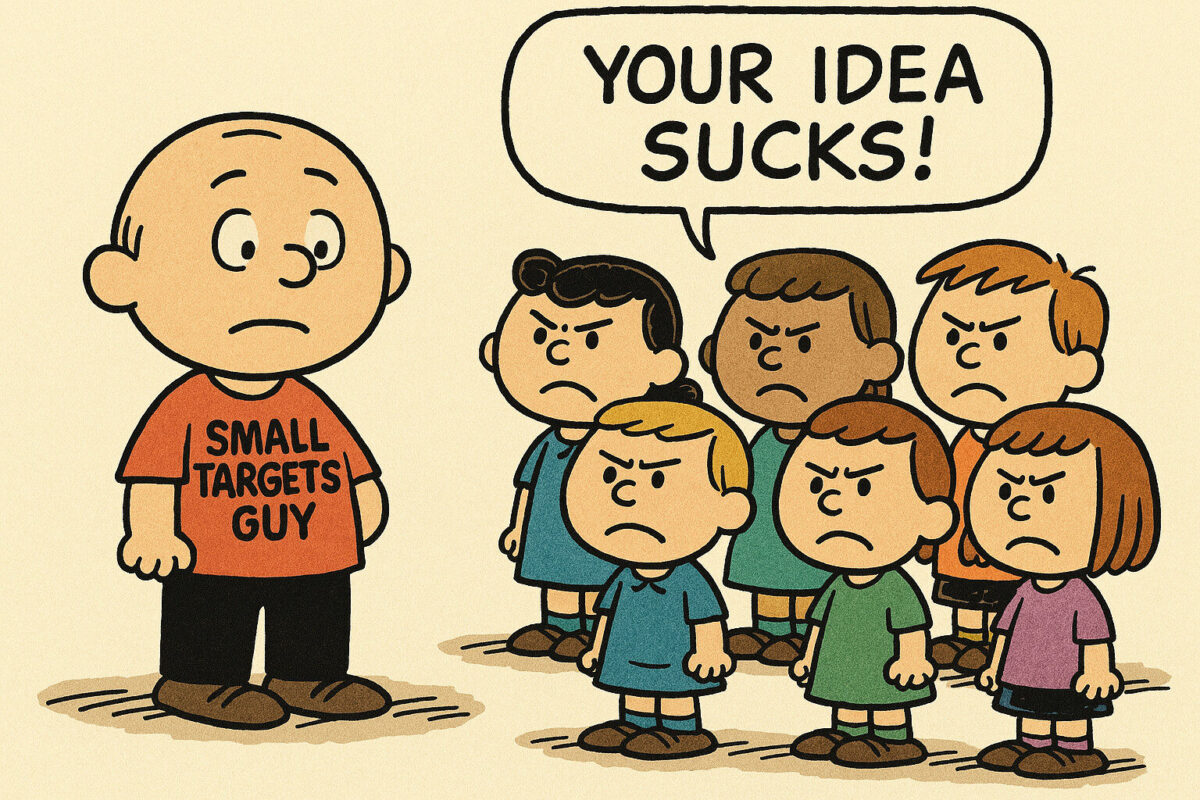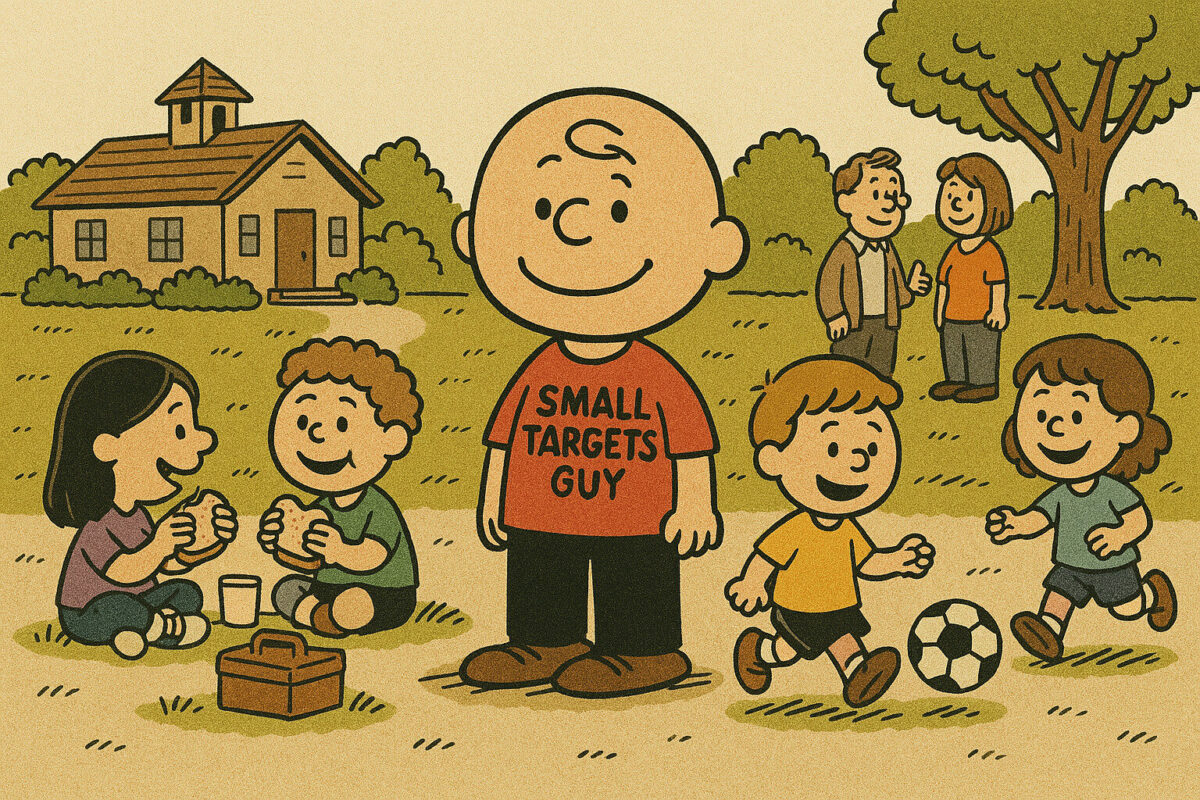‘Small Targets Guy’
I used to be a dreamer. Always chasing something new, imagining ways things could be better. I was outspoken and optimistic. Maybe foolish, undoubtedly naive. Being a teenager didn’t help.
But life has a way. My dreaming dulled, for reasons too complex to unpack here. I turned inward. Introspective, cautious, and unwilling to stick my head above the proverbial parapet.
I became a Small Targets Guy.

It’s worked well enough for the past decade, allowing me to ply my trade in strategic marketing, communications, and design. Goodness, it even led to Bolsta Education becoming a thing. I shouldn’t be too hard on myself.
But about six months ago, I felt that itch again.
Which is, for a now-well-practised Small Targets Guy, a pretty scary feeling. I feel uncomfortable with putting a big thought out into the wild… What if I realise it’s all just a fad? What if a thousand other wonderfully insightful thinkers around the world have already written exposés on the top hundred reasons why my idea sucks and will never work in a million years?
I fought it for a little while, but I think I’m giving in. So now I find myself here, writing this rambling piece, inviting you to wonder with me.
Cracks in the frame
Education builds the future, or so we say.
Yet as a system, education is full of cracks. Neoliberal influence prioritising economic outcomes over human ones, funding disparities sharpened by economic divides, persistent racial and class biases, and suffocating teacher workload to name a few. Education regularly becomes a political football. A match no one asked for, mind you.
Perhaps a better metaphor would be rugby. Receive the ball and 3 seconds later there’s a 110kg forward hurtling into your sternum.
Amidst all this, it seems we rarely pause to ask with an open-mind:
If education shapes our future, why do we leave so much of it to chance?
Between ages 5 and 18, a child spends roughly 20% of waking life at school. Shouldn’t every one of those precious hours spent at school matter?
I vividly remember the day my Year 6 teacher Mrs Hawgood let me build a computer from a pile of old components. The details have faded with time, but not the feeling. I was seen. Trusted. Empowered. I remember that moment now as a crucial part of my developing interest in understanding how things work. Can you tell? I’ve never stopped loving pulling things apart and putting them back together.
Rest in peace Mrs Hawgood, you were excellent.
School experience is often accidental
Ask anyone to reflect on school, and they’ll share moments of joy, connection, heartbreak, or frustration. If there’s a complaint to be made, then it’s usually summed up with the statement “I had a bad experience.” Not bad curriculum, not a lack of a state-of-the-art gym, not terrible education policy, not an overworked teacher. Experience. Personal, emotional, human.
Yet it seems to me that the experience of school is largely accidental. If we teach the curriculum well, if we get the grant for the awesome new gym, if the incumbent government introduces spectacular education reform, little Josie and her family will have a great experience. Right? Right?
The best answer to that is a meek “maybe?”
Who knows? This, to me, feels like a crucial missing piece of the education ecosystem. Not because it doesn’t exist, but because we rarely see it as something that can be intentionally shaped. It happens by default, not design.
The moments that make us
My wife is an educator. Every day she comes home with stories that move me… small yet brilliant moments of connection and discovery with her students and their families. Her stories make me wonder:
“What if the conditions that allowed these special moments to occur were better understood?”
“What if they were intentionally shaped?”
Our lives are made up of moments. Some profound, others forgettable, but together, they define us. Experience isn’t abstract. The conditions in which positive experiences occur can be designed for.
Experiences are valuable
Experience strategy is the deliberate, cross-disciplinary design of the conditions, systems, and signals that shape how someone feels when they interact with your school.
It asks: how are people meant to feel at each key moment? What should they understand? What should they feel confident to do next? And (critically) what conditions make that possible, not just once, but consistently?
Think of Disneyland. They design every moment of the Disneyland experience, from the smells to the queue. AirBNB asks me to select the particular type of experience I’d like when searching for accommodation. In digital spaces, UX designers know that a small arrow or colour choice can shape how easily a user can get the job done.
Pine and Gilmore argued many years ago that in a mature economy, experiences become the differentiator. In education, we rarely treat experience as an asset. But what if we did? What if trust, belonging, and clarity weren’t soft extras, but the things that made every other system work better?
What if we stopped treating the experience of school as something that just happens, and started treating it like something we could deliberately shape?
Pause.
I’ve asked a lot of provocative questions about schools. Don’t let my rhetoric fool you, I know that schools deeply care about experience. Many schools have thoughtful practices around care and connection.
What I’m describing here though is something different: a shift in organising principle. A deliberate design of the in-between. Not an add-on, but a reframe.
And to be clear, this is hard work! Schools are some of the most complex melting pots in our society – designing anything for schools is hard.
A more cynical take is that investing into designing experiences isn’t a particularly attractive idea to policy-makers, precisely because it’s emotional, subjective, and messy. Famously hard metrics to quantify against OECD benchmarks.
John Hattie reminds us, “Learning is a function of relationship, and relationship is a function of experience.” If that’s true, then I ask again: why not deliberately craft these experiences?
Maybe this is where my generalist wiring – part strategist, part communicator, part designer – finally clicks. Because experience design demands a wide lens, a sense of wonder, and frankly, enough stubbornness to keep experimenting until it works.
Imagine a school designed around moments that matter. Moments shaped deliberately, thoughtfully, lovingly. Moments not left to chance.
Designing for connection
It’s your child’s first day of school. They’re excited. Nervous. So are you.
You carefully pack lunch and dress them neatly, but when your precious bundle of joy arrives home, you discover that the crackers you packed should have been a piece of fruit, and the very cute pink ribbon that secured the braid in place was actually against uniform policy. Blue hair ties only please.
Yikes. Great first day, team.
It’s a low-impact example, sure. But even in this moment, what would it mean to design for both the student and the parent experience? To make families feel just as seen, known, and welcomed as their children?
And perhaps prevent a few parent panic-attacks along the way?
Imagine a different school. One that anticipates these moments. A school where orientation isn’t just paperwork but a thoughtfully crafted experience, welcoming and reassuring, designed with clear intention.

What if schools took experience design seriously? Not as a nice to have, but as a core organising principle alongside curriculum and wellbeing?
Well, I suggest you might just find that your curriculum and wellbeing outcomes improve when the experience is well-designed. Perhaps experience isn’t an either/or to academic rigour or other organising principles; perhaps it’s the rich, organic soil in which those things thrive. Students who feel seen and supported learn more deeply, engage more fully, and achieve more authentically. Parents who feel a sense of belonging are more likely to be engaged with their child’s education.
Good experience strategy replaces accidental complexity with intentional coherence. It shapes school culture in ways that are observable, repeatable, and strategically aligned.
This shift has begun; it isn’t hypothetical. The language of thriving schools, inclusive communities, and genuine belonging grows louder. Education might finally be catching on. Experience is central, not peripheral.
I still hold caution close (Small Target Guy isn’t completely done away with). But increasingly, I think the way our education systems (at every level) design and shape experiences for children, parents, families, and communities will profoundly influence the future of our world.
I think I’d like to be a part of this move. Would you?
